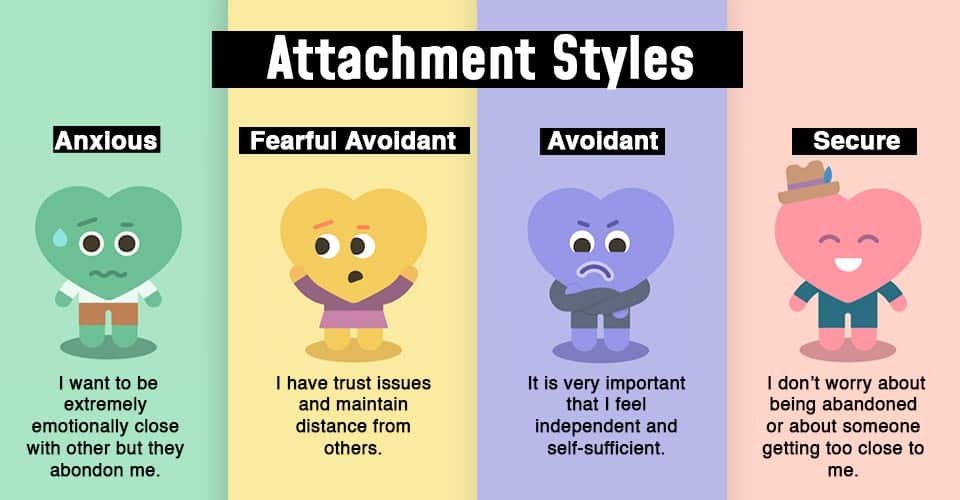We often think our study habits are purely about discipline or intelligence. But what if your academic drive—or lack thereof—is tied to how safe and supported you felt growing up? That’s the core idea behind attachment theory, a psychological framework suggesting that our earliest bonds shape how we relate to others and manage stress. As college students navigating deadlines, teamwork, and pressure to perform, our attachment style might quietly be steering our focus, motivation, and sense of belonging.
Attachment theory, developed by John Bowlby and Mary Ainsworth, describes how infants develop emotional bonds with their caregivers. These early patterns influence how we manage relationships and regulate emotions throughout life. There are four main attachment styles: secure, anxious (preoccupied), avoidant (dismissive), and disorganized (fearful-avoidant). In infancy experiments, securely attached babies became upset when their parents left but were comforted upon their return. Anxiously attached babies cried intensely and were difficult to soothe. Avoidant babies showed little reaction, while disorganized babies exhibited erratic, frightened behaviors. Decades later, these patterns often carry into adulthood. In brief, securely attached individuals are comfortable with both closeness and independence, communicate their needs, and trust in the support of others. Anxious individuals tend to fear abandonment, overthink, doubt their self-worth, and crave constant reassurance. Avoidant individuals prefer independence, often distrust others, and typically avoid emotional intimacy. Disorganized attachment is often rooted in trauma; individuals’ desires—longing for closeness but simultaneously fearing it, leading them to push others away. This pattern is commonly linked to early experiences of trauma or chaotic caregiving. Psychologists describe individuals with disorganized attachment as highly anxious and unpredictable. Each attachment style forms a lifelong internal working model of relationships, influencing how a student interacts with peers, works in teams, manages time, seeks help, copes with challenges, and perceives academic success.
According to Kurland and Siegel in their longitudinal study published in the Open Journal of Social Sciences (2020), students with secure attachment generally display greater resilience, self-efficacy, and emotional regulation. Studies show they are more likely to take on academic challenges, use effective coping strategies, and bounce back from setbacks. Their sense of internal stability allows them to focus, plan, and engage meaningfully in group settings. Secure students also tend to build stronger connections with professors and peers, allowing for academic support systems that further enhance performance. In contrast, insecurely attached students often encounter academic struggles.
Anxious students may procrastinate, over-prepare, or become paralyzed by fear of failure. According to a 2024 study published in the Journal Adolescent and Youth Psychological Studies, research links anxious attachment to lower GPAs, higher levels of stress, and greater reliance on academic validation. Avoidant students, on the other hand, often keep their distance and avoid group work, mentorship, or even asking for help. In their research on university students, Sayedi, Yazdanbakhsh, and Karami (2017) found that this self-isolation, while preserving autonomy, can limit opportunities for growth and collaboration. Disorganized students, though less studied, often show erratic performance. Their internal confusion can manifest as difficulty concentrating, inconsistent effort, and heightened academic anxiety.
In one longitudinal study, Kurland & Siegel (2020) found that secure students maintained higher GPAs and reported more consistent motivation than their insecure peers. These findings suggest that attachment patterns affect not only emotional regulation but also tangible outcomes like grades and academic persistence.
Source: thewaveclinic.com
Attachment style also shapes how students manage academic stress. Secure students are more likely to reframe stress as manageable and adopt problem-solving approaches. Anxious students may catastrophize minor setbacks, leading to rumination and burnout. Avoidant students tend to suppress stress, which can result in emotional detachment or delayed breakdowns. Additionally, attachment styles influence productivity patterns.
- Anxious students may seek constant reassurance, making them prone to distraction.
- Avoidant students may isolate themselves to focus but resist constructive feedback.
- Disorganized students might cycle between bursts of energy and emotional withdrawal.
Recognizing these patterns can help students develop healthier academic habits. For example, anxious students may benefit from grounding techniques and structured planning. Avoidant students could practice seeking feedback in low-stakes settings. Disorganized students may require personalized support or counseling to better regulate their academic emotions.
Collaboration is a vital part of college life, and attachment styles influence how students navigate it. Secure students are generally open, communicative, and cooperative in team settings. Anxious students may worry excessively about group acceptance or fear contributing poorly, while avoidant students might disengage or dominate in order to protect their autonomy. A 2017 study by Sayedi, The Relationship Between Attachment Styles, Self-Regulation, and Academic Achievement in Students, found that attachment insecurity was correlated with poor peer support and communication difficulties in group tasks. Without awareness, these dynamics can hinder learning and create tension within student organizations, internships, or group projects.
Attachment styles aren’t fixed destinies. With self-reflection, supportive environments, and emotional tools, students can move toward more secure patterns. This includes:
- practicing emotional regulation (e.g., journaling, mindfulness);
- building safe relationships where feedback is normalized; and
- seeking mentorship and mental health resources when needed.
We often measure success through effort and intellect. Yet beneath the surface, invisible forces like attachment styles may be shaping whether we lean into challenges or retreat from them. By unpacking these internal patterns, college students can replace self-sabotage with self-awareness—transforming attachment from an unseen barrier into a powerful tool for growth, both in the classroom and within themselves. (ANF/NYL)
You may also like
Pasca-Ujian Tengah Semester: Istirahat Dulu atau Overthinking Nilai?
Dahulu Belajar Akuntansi, Sekarang Jadi Content Creator
Teror Verbal di Balik Tembok Kampus
Frugal Living: Strategi Bertahan Hidup di Tengah Gempuran Ekonomi Modern
Magang Bergaji vs Magang Non-Bergaji: Ini Hal Penting yang Perlu Diketahui oleh Mahasiswa!


